Are You A Vanguard? Applications Now Open
Artist Cesar Inostroza repairs his murals from damage that occurred during the construction of the new overpass.
Corrie Boudreaux/El Paso Matters
This is your first of three free stories this month. Become a free or sustaining member to read unlimited articles, webinars and ebooks.
Become A MemberSince the early 1980s, the freeway columns at El Paso’s Lincoln Park have served as a canvas for Chicano artists. The community center within the park has been around for more than a century, housing part of the region’s history.
But Lincoln Center was set to be demolished on May 20, 2014, when bulldozers lined up in front of the abandoned historic building to tear it down to make way for a new freeway project by the Texas Department of Transportation. Some surrounding columns featuring murals by renowned local artists were also to be torn down, according to local activists. A human chain stopped the demolition as community activists and area neighbors faced off with work crews to halt the machinery.
“One of the most beautiful sights that I remember is we were all lined up in front of the bulldozer,” says Lily Limón, a retired educator and former City Council member, remembering the protest almost 10 years later. “When the police told (the demolition crew), ‘You have to go,’ and then the group walked (up), literally pushing them out. When they were off the grounds, there was a tremendous cheer. Every person there felt what success was like.”
Community organizers say the fight to save the more than 110-year-old building, which once served as a school for segregated minority children and later as a community recreation center, started in 2005. The aging center was losing programs once available to the community, so Lincoln Park Conservation Committee volunteer artists got together to hold events and promote the center and the park that housed it.
Nearly two decades later, after countless struggles, hours of dialogue – and several changes in government leadership – the building on Durazno Street in South Central remains in place with plans to house the Mexican American Cultural Institute, an El Paso nonprofit organization founded in 2016.
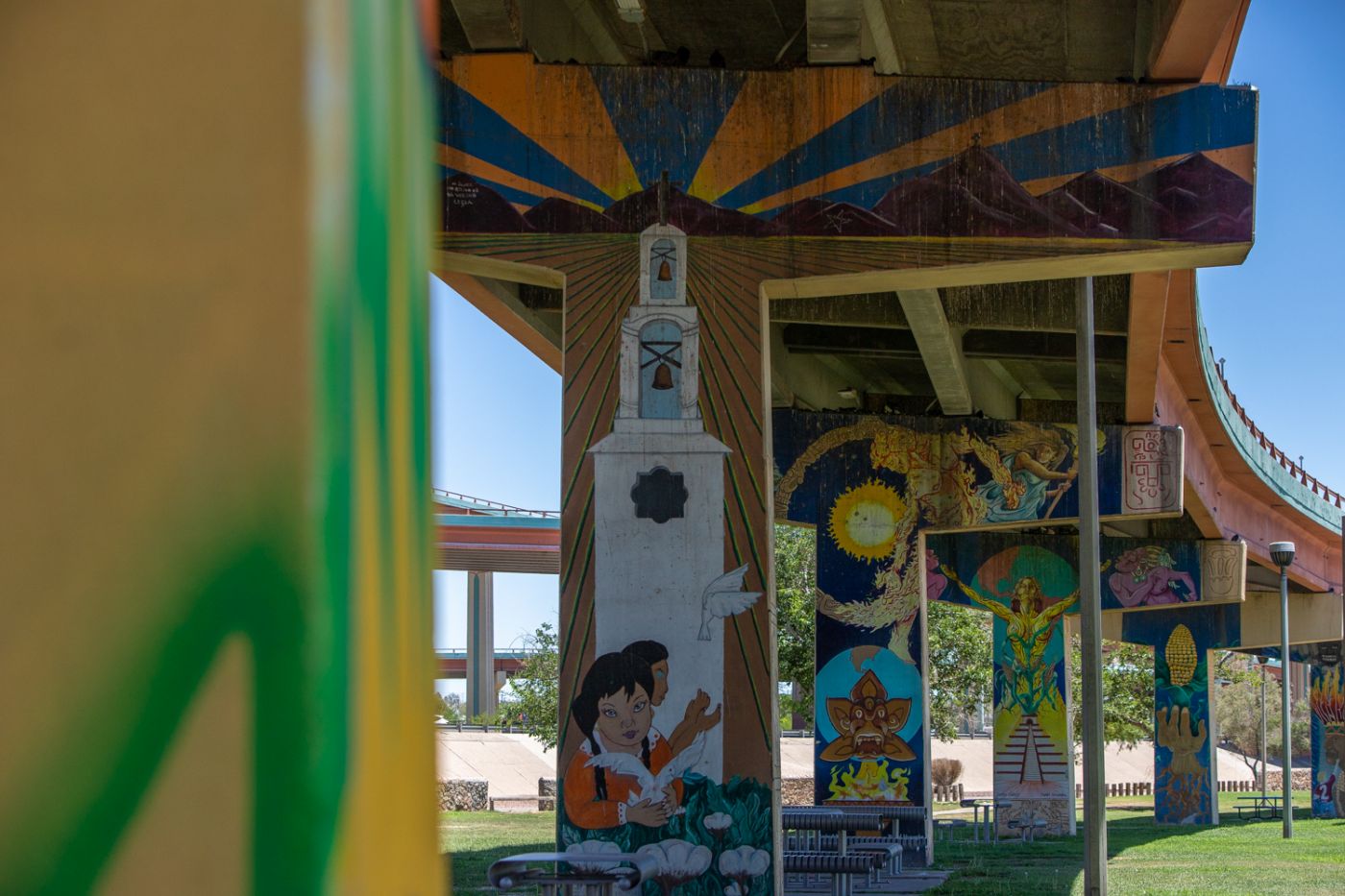
Lincoln Park's "elements row" of murals shows artists' interpretations of water, earth, wind and fire. (Corrie Boudreaux/El Paso Matters)
The organization wants to turn the building into a $12.5 million cultural center with a dance studio, theater, art gallery and gift shop, says Limón, who serves on the Mexican American Cultural Institute board. The multi-purpose center and institute, which is in the design phase, will be funded through private donations with an expected opening date of late 2024 or early 2025.
“We have raised funding to hire an architect who has presented us with tentative building designs,” Limón says. She didn’t disclose exactly how much money had been raised.
For now, the building sits vacant behind a chain-link fence as the city park around it still houses enormous murals on the columns that hold up the freeway lanes above. The park continues to serve as a site for special events and for neighboring families to enjoy, even as freeway construction work goes on around it.
“You have to outlast the enemy, simple as that,” says Limón, who served on the El Paso City Council when she fought to save the center. “There have been a lot of tears, a lot of frustration, a lot of anger. Boy, I tell you what, when the demolition was going to take place, Hector was on fire. You need that commitment. There was a paddywagon ready to take us.”
“Hector” is Hector Gonzales, a Lincoln Park Conservation Committee member who promotes the park area as a tribute to the region’s Chicano and Mexican American culture. Gonzales says the 19-year fight lasted until state and city officials who opposed saving the center were no longer in office.
“You have to be committed 100%,” says Gonzales. “Halfway into it, we realized … we’ll have to just continue. Never give up. Outlasting the politicians and the administration, and that’s sometimes the only way to get things done. We waited out city councils. We waited out mayors. We waited out TxDOT engineers. We waited them all out 19 years, and we’re still here.”
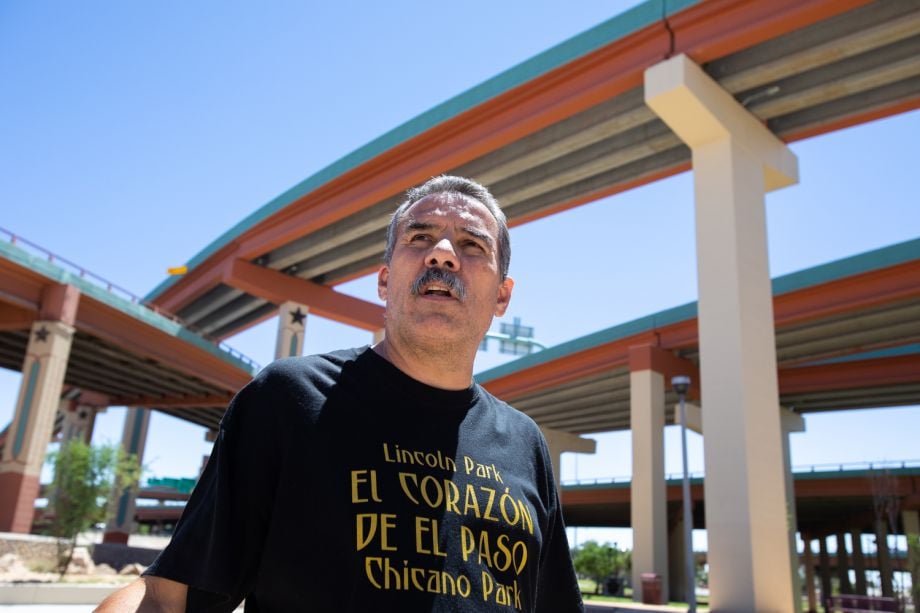
Hector Gonzales of the Lincoln Park Conservation Committee shares his knowledge of the park's history. (Corrie Boudreaux/El Paso Matters)
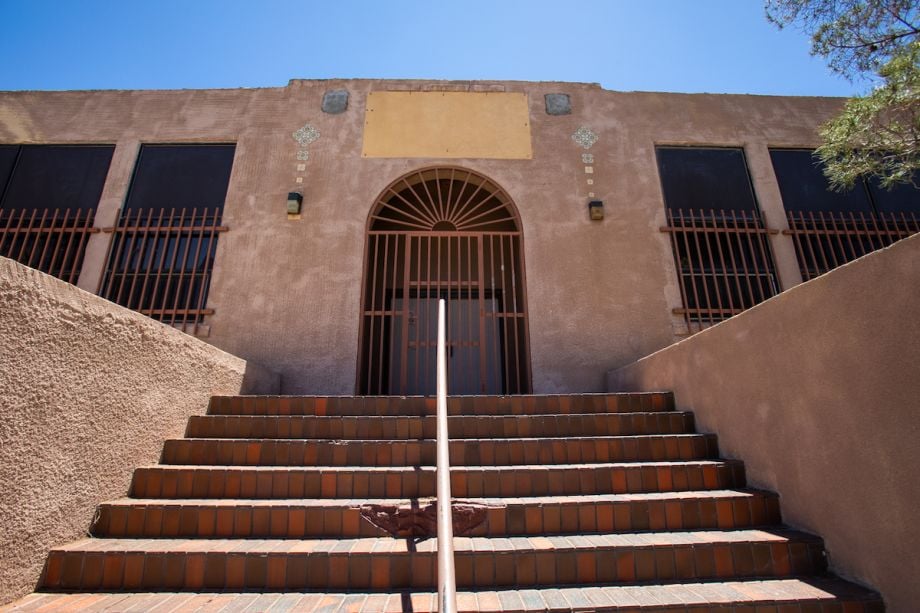
The Lincoln Center, formerly a school named after Abraham Lincoln, is under renovation. (Corrie Boudreaux/El Paso Matters)
While Gonzales and local historian and activist Miguel Juárez attended a 2014 El Paso City Council meeting to hear about possible plans for the center, Lincoln Park was taken over by a demolition crew.
“They were bringing in trailers and putting up fencing around the building to get ready to demolish,” Gonzales says.
The group rushed to social media and mobilized about 100 people who, within an hour, took to the park to protest the demolition. Three hours later, the number grew to 250.
“They were building human chains holding hands,” Gonzales says. “We held our ground for nine days and nine nights. The community spent the night; we set up tents. Nobody left the site.”
Some relief came in the form of a temporary injunction three days into the protest procured to stop demolition at the site.
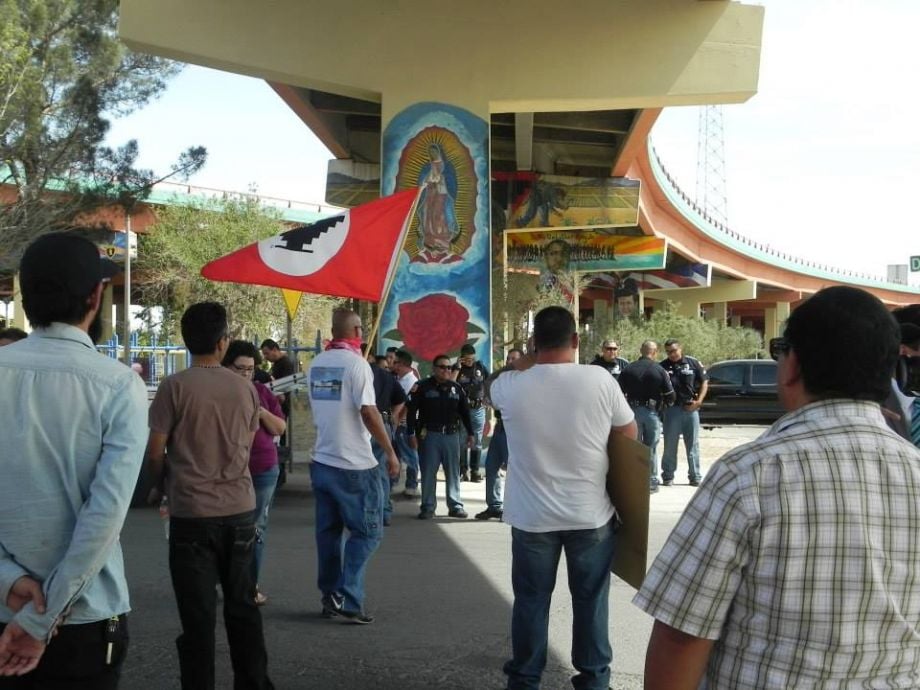
A group of protesters faces police while fighting to save Lincoln Center in 2014. (Photo courtesy of Lincoln Park Conservation Committee)
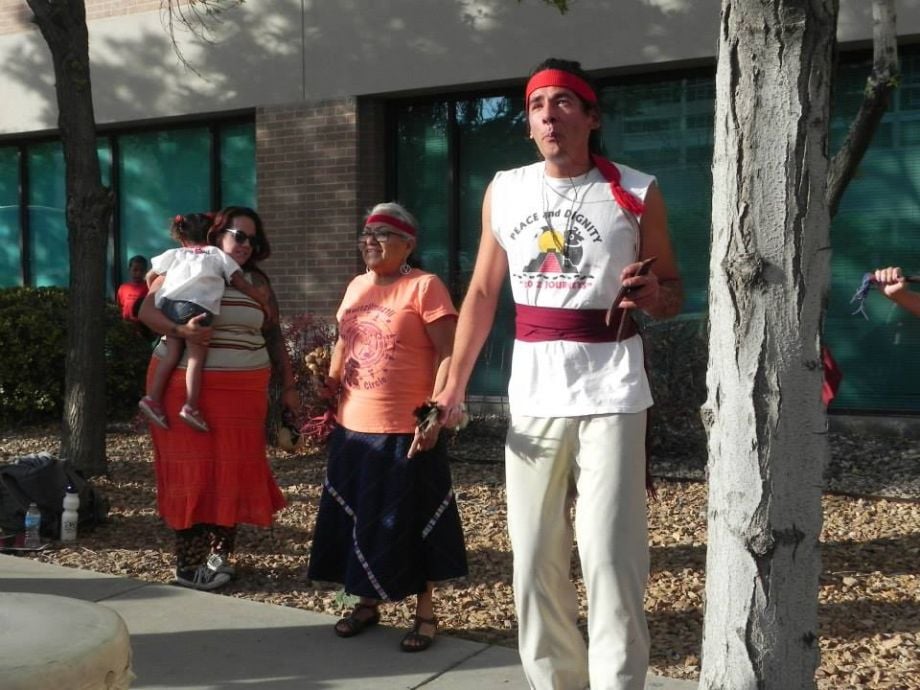
Matachines — traditional Mexican dancers — showed support to save Lincoln Center during a 2014 protest at City Hall. (Photo courtesy of Lincoln Center Conservation Committee)
“What’s interesting is that the demolition company never said, ‘We’re ready to demolish,’” Limón says. “Shortly thereafter, we went into the building … and you could see at the corners where they had already laid out boxes where it was going to be demolished.”
“We continued (protesting) for nine days just to be sure,” added Gonzales.
Limón says the quick mobilization was thanks in part to the people of the community who alerted them to any suspicious movement in the center.
A compromise was later reached between the organization and TxDOT with a plan to spare the center from demolition. However, more than a dozen murals have been removed as the columns that housed them for many years were to be destroyed and new columns erected.
The history of Lincoln Center dates back to the mid-1800s as a school for military kids of Camp Concordia in a settlement by Hugh Stephenson. In the 1910s, the school was renamed Abraham Lincoln and served as the only school that Mexican American and African American children in the area could attend.
“That’s why it holds such a special place in the Mexican-American community,” says Gonzales.
Ownership of the land has passed through many hands, with Stephenson and his wife, Juana Maria Azcarate, as the original owners. Then, in 1923, the city of El Paso gave the deed to El Paso Independent School District. In 1969, EPISD gave it over to the State of Texas as a staging location for constructing a major freeway interchange known as the Spaghetti Bowl that crisscrosses over Lincoln Park.
“That’s the only reason that the building was not demolished way back in 1969,” says Gonzales. “But now it’s the last remaining public structure in the entire neighborhood.”
As a result of the highway expansion at the time, minorities were split geographically, with Chicanos on the south side of the freeway and Black communities on the north side, Gonzales says.
“The school stayed on the south side of the freeway; thus, the Mexican-American community is the one that is taking more pride and more ownership of the school and its meaning,” he says.
A year later, a resolution was approved for the local government to use the building under a lease with the state, and a remodel was approved in 1975.

A row of murals depict Chicano/Pachuco culture and their Mexican roots at Lincoln Park. (Corrie Boudreaux/El Paso Matters)
From 1977 to 1987, Lincoln Center served as the office for the city’s parks administration and the nonprofit LULAC Project Amistad, which serves older people and persons with disabilities. The center featured a recreation room, meeting room, classrooms for informal gatherings and a gallery featuring monthly exhibitions by local artists. During this time, the city spent more than $210,000 renovating the center.
For the next decade, it continued serving as administration offices and held monthly exhibits, but it no longer offered public services. That was primarily because the population in the area ‘declined, and other centers that provided services and activities for youth and seniors were built in nearby neighborhoods, according to city documents.
In 2005, Lincoln Park Day, an annual festival featuring lowriders, murals and music celebrating Chicano culture, began its first iteration. It continued the following year amid several floods that afflicted the city. Then, in the summer of 2006, heavy rain and thunderstorms brought destructive floods to the area, severely damaging the area.
“But even a month later, we utilized the park, and we had thousands of people there,” Gonzales says. “So the flood never really even did damage to the park. Much less the building. The building was still open and functioning when we had the second Lincoln Park Day in 2006.”
A month later, the city closed the building, citing water damage, while activists believed it would be remodeled and the community center would reopen.
“They came in, closed the doors and got everybody out of the building,” says Gonzales. “(They said) it would be a few months.”
In 2011, the city began planning a multi-million-dollar quality-of-life bond issue and proposing projects to be included in it for voters the following year. One option was the renovation of the Lincoln Center.
But a 2011 report from the city of El Paso said that the 2006 flood severely damaged the center. A microbial investigation conducted by an outside consultant concluded that asbestos and mold were present in the building. Staff members reported respiratory ailments due to contaminants, prompting the city’s health director to close the center and vacate all personnel.
The bond passed in 2012 and included funding for a cultural center – but didn’t specify a location. Years later, when a site was being chosen, the El Paso City Council took Lincoln Center off the table.
As that and other preferred sites were scrapped, a group of Mexican-American community and elected officials, including Limón, former U.S. Representative Silvestre Reyes and former State Senator Jose Rodriguez, formed MACI.
The council later voted to build what it’s calling the Mexican American Culture Center at the Main Library branch in Downtown El Paso, using funds from the 2012 bond. The MACC is now under construction and will be overseen by the city of El Paso’s Museums and Cultural Affairs Department.
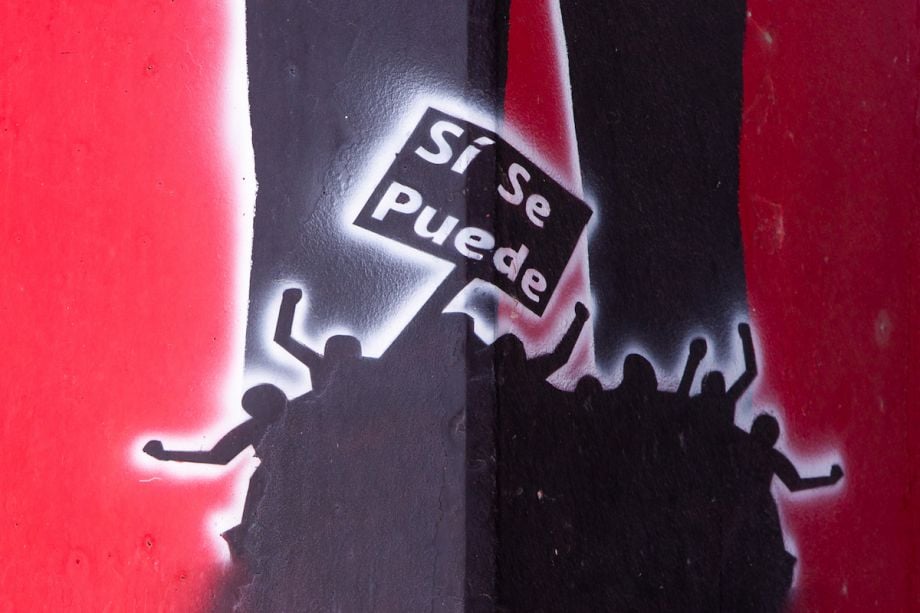
A detail of a mural dedicated to Dolores Huerta, just adjacent to Durazno Street at Lincoln Park. (Corrie Boudreaux/El Paso Matters)
MACI wanted its own stand-alone cultural center and made a deal with TxDOT to lease the Lincoln Center in January 2022 and make it its home. The lease is for 25 years with a possible extension of 10 more.
Plans for the area include keeping the original two-story building structure while adding expansions to host a gallery, culinary center, terrace and clinic to serve community members.
Activists say that a tense relationship with the state at first became fruitful when TxDOT cleared the building of asbestos at its expense.
“When I think of TxDOT prior to the construction of the (freeway project), to me, they were pretty evil people,” Limón says. “Now they’re good partners with us.”
The shift in the relationship came about after personnel changes within the Texas Transportation Commission and the Texas Department of Transportation, particularly when Tomas Trevino was hired as the new TxDOT district engineer for El Paso.
“He’s very sympathetic to the community. Finally, somebody that listened,” Gonzales says.
Limón echoed Gonzales’s sentiment, recalling meetings with TxDOT executives that had left a sour taste in her mouth and made her feel like they did not care for or empathize with the community. It’s a very different relationship with Trevino, she says.
“He is somebody that has empathy, somebody that understands the community, and someone that wants to make our community a better place, not destroy it, but continue building on the base,” she said.
Trevino tells Next City through a statement from a TxDOT spokesperson that the relationship with the activists has been fruitful and beneficial to the people fighting to save Lincoln Center and the park where it sits.
“We have enjoyed collaborating with local community leaders to deliver a park everyone can enjoy,” he says. “TxDOT is proud to have kept its commitments to the community, based on comments we received during our many public outreach efforts, to keep the Lincoln Center, the amphitheater and improve the park.”
Even after defeating the demolition of the building, Gonzales said the fight to preserve spaces to celebrate Hispanic culture continues. He reminisces about the struggle to save San Diego’s Chicano Park from being turned into a parking lot in the 1970s and for continued upgrades since. In Denver, after several years, the city approved La Alma Lincoln Park to showcase Chicano culture, as Next City’s Oscar Perry Abello has reported.
“As far as the Lincoln Park committee, we continue with the park and generating events … that has never stopped for 19 years,” Gonzales says. “As far as that 19-year fight (being) over. Never, never, never back up one step, never. Keep moving forward all the time.”

Christian De Jesus Betancourt is Next City and El Paso Matters' joint Equitable Cities Reporting Fellow for Borderland Narratives. He has been a local news reporter since 2012, having worked at the Temple Daily Telegram, Duncan Banner, Lovington Leader and Hobbs News-Sun. He's also worked as a freelance reporter, photographer, restaurant owner and chef. Born and raised in Juarez, El Paso became Betancourt’s home when he moved there in the seventh grade.

20th Anniversary Solutions of the Year magazine